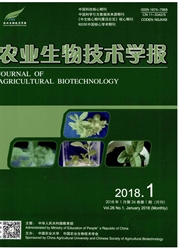

 中文摘要:
中文摘要:
梨火疫病菌(Erwinia amylovora)是一种具有毁灭性的植物病原细菌,能够侵染梨、苹果和其他蔷薇科植物引起火疫病,造成严重的经济损失。luxR家族调控因子具有重要的生理生化作用,是细菌群体感应机制中研究较多的一类重要的转录调节基因。本研究采用PCR技术从梨火疫病菌中扩增出一个luxR同源基因,命名为EaluxR,应用同源重组的方法构建了突变株(Ea△luxR),并对其功能进行初步研究。实验结果表明,Ea△luxR与野生型菌株相比产生的多烯大环内酯类代谢产物在抗氧化压力和生长情况方面有明显差异,对梨幼苗及幼果的致病能力下降;但是Ea△luxR仍能引起烟草过敏性反应,并且在抗生素耐受水平和生物膜的生成方面与野生型菌株相比没有明显差异。研究表明,梨火疫病菌对病菌的生长、次级代谢产物、抗氧化压力以及致病性方面具有关键作用,为深入认识梨火疫的群体感应系统提供了科学依据。
 英文摘要:
英文摘要:
Erwinia amylovora is a necrogenic phytopathogenic bacterium, the causal agent of fire blight in pear(Pyrus sorotina), apple(Malus domestica) and other members of the Rosaceae family, causing seriouseconomic losses. LuxR transcriptional regulator is a key player in quorum sensing and plays important physiological and biochemical roles. In this paper, one of luxR homologous gene was amplified by PCR fromE. amylovora. The mutant Ea△luxR was successfully constucted by homologous recombination, and the function studied preliminarily. The experimental results showed that, compared to the wild-type strain, thepolyene macrolide biosynthesis, anti-oxidative stress, growth, and pathogenicity of mutant Ea△luxR declined. However, Ea△luxR still caused tobacco(Nieotiana tabacum) hypersensitive response, and there was nosignificant difference in antibiotic tolerance level and biofilm formation comparing to wild-type strain. These findings demonstrated that luxR gene in E. amylovora is involved in polyene macrolide biosynthesis, growth,and anti-oxidative stress and plays an important role in virulence. In addition, our results provid molecular evidence for in-depth understanding of the quorum sensing system of E. amylovora.
 同期刊论文项目
同期刊论文项目
 同项目期刊论文
同项目期刊论文
 期刊信息
期刊信息
